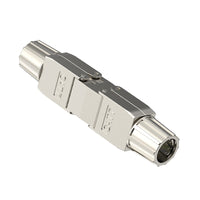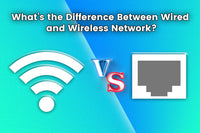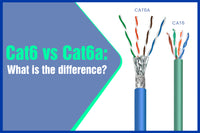Contents
Ethernet has been indispensable in our daily life for decades since it was first introduced by Bob Metcalfe in 1973. Ethernet allows your devices to communicate and connect with people in different places. Ethernet cables are commonly used in LAN networks, but do you really know knowledge about Ethernet cables? This article explains everything that you want to know about Ethernet cables.
What is Ethernet Cable?
Though WiFi has become ubiquitous nowadays, many individuals still prefer wired networks for their consistent and reliable speeds. The proper implementation of network cabling is crucial in maintaining a high-speed and stable network. Poorly planned network and poor-quality Ethernet cable can affect the success of network cabling. Ethernet cable is the backbone of the network cabling, connecting various devices such as computers, routers, TVs, tablets, or even PlayStations.
Take a look at your router and you’ll find Ethernet ports for RJ45 plugs. RJ45 plugs are usually terminated at the end of Ethernet cables and all network data is transmitted through the Ethernet cable.
Ethernet Cables Structure
You may be familiar with the outer appearance of Ethernet cables, but do you know the inner structure of Ethernet cables? Ethernet cables come in different lengths, types, and categories, and the structure can differ. But all of them feature eight wires twisted into four pairs and a rip cord. A twisted pair can reduce crosstalk from the neighboring pairs to be more resistant to electromagnetic interference (EMI). A rip cord is usually designed to cut the cable jacket for convenience.

Shielded Ethernet cables typically contains a drain wire along with braid or foiled shielding. Have you ever been confused about the purpose of the drain wire and wonder its distinction from the ground wire? You’ll get it in the following explanation.
About Drain Wire
A drain wire is usually contained in a shielded cable to allow for a continuous connection with the cable’s metal shielding to offer an excellent grounding. Be careful not to cut off the drain wire in the network installation. Beyond its ground function, the drain wire also contributes to minimizing electrical noise. Notably, either drain wire or braid shielding can be used as an effective ground wire.
Ethernet Cable Types
Ethernet cables have been continuously updated to meet different needs for the network. Ethernet cables can be classified into different types according to different shielding types, categories, and styles.
Ethernet Cable Categories
When you look for the specific Ethernet cable on the market, you’ll notice that Ethernet cables labeled with different “Cat” designations. Do you know the meaning of “Cat”? “Cat” stands for Category, often followed by a number. In general, a higher number indicates better performance for the Ethernet cable. We list the following common Categories:
- CAT3: CAT3 is the third category of Ethernet cable, composed of 3 twisted pairs of copper wires. CAT3 cables were used in the computer network in the 1990s, supporting 10-BaseT Ethernet. The maximum bandwidth of the CAT3 cable is 16 MHz, and it is compatible with RJ11 or RJ12 connectors.
- CAT4: CAT4 cable is also named as Category 4 cable, which consists of 8 copper wires twisted into four pairs. CAT4 cable was the first Ethernet cable to use the RJ45 connector. The frequency of the CAT4 cable is up to 20 MHz.
- CAT5: As the fifth category of Ethernet cable, CAT5 cable also features four twisted pairs of copper wires. Most CAT5 cables are unshielded on the market. CAT5 cables were once widely used in the home network, but it has been gradually replaced by CAT5E cables.
- CAT5E: The CAT5E cable is an augmented version of the CAT5 cable. Invented in 2001, the CAT5E cable was the first Ethernet cable to reach 1000BASE-T (Gigabit Ethernet) speeds. CAT5E cables also use RJ45 connectors, and they have been prevalent in the past years.
-
CAT6: Category 6 cable was published by Telecommunications Industry Association in 2002, and it did the most obvious structure. It features a spline in the center to reduce crosstalk from each pair of copper wires. The maximum bandwidth of CAT6 cable can reach 250 MHz, and the top speed can be 10 Gbps within 55 meters. CAT6 can be shielded or unshielded, and you can choose one according to your own needs.
CAT6 stands out as the most prevalent cable category in most modern houses and offices for its versatility and cost-effectiveness.
- CAT6A: CAT6A cable was introduced in 2008, which is an augmented standard of CAT6 cable. The maximum bandwidth of CAT6A cable can reach 500 MHz, and the maximum data rate is up to 10 Gbps. CAT6A cables are generally used for large business networks or data centers.
- CAT7: CAT7 is not recognized by TIA or ANSI and is a specification defined by ISO/IEC. The CAT7 cable was designed to be compatible with ARJ45 and GG45, but it can also be used with RJ45 connectors.CAT7 Ethernet cables are used primarily in data centers.
- CAT8: CAT8 cable is the latest standard of Ethernet cable. CAT8.1 was introduced in 2016 and can reach a maximum speed of up to 25 Gbps. CAT8.2 was made for 40GBase-T Ethernet. CAT8 cables are also mainly used for data centers and other professional applications.
The data rate of an Ethernet cable is intricately linked to the size of its electrical conductor. The larger conductor contributes to lower resistance and signal loss. The conductor size is quantified by the American Wire Gauge (AWG) standard. It should be noted that the larger the AWG gauge, the smaller the conductor diameter.
Ethernet Cable Shielding
Cable Shielding Types
|
Shielding Types |
Abbreviated Form |
Conductor Shielding |
Overall Shielding |
|
Unshielded Twisted Pairs |
U/UTP |
None |
None |
|
Foiled With Unshielded Twisted Pairs |
F/UTP |
None |
Foil |
|
Unshielded With Foiled Twisted Pairs |
U/FTP |
Foil |
None |
|
Shielded With Unshielded Twisted Pairs |
S/UTP |
None |
Braiding |
|
Shielded and Foiled With Unshielded Twisted Pairs |
SF/UTP |
None |
Braiding&Foil |
|
Foiled With Foiled Twisted Pairs |
F/FTP |
Foil |
Foil |
|
Shielded With Foiled Twisted Pairs |
S/FTP |
Foil |
Braiding |
|
Shielded and Foiled With Foiled Twisted Pairs |
SF/FTP |
Foil |
Braiding&Foil |
Ethernet Cable Styles
Ethernet cables come in different styles according to various applications and different performances. These cables vary in length, enabling you to either select a pre-terminated size or customize by cutting to the desired length. They also come in various colors and they all perform the same. Besides the standard Ethernet cables, a lot of Ethernet cable styles are available to cater to specific needs. Here are some examples.
Slim Ethernet Cable
Slim Ethernet cables are generally thinner than standard cables and are very suitable for homes, offices, and data centers where the place is very tight. Slim Ethernet cables can also offer a larger area for other devices.
Flat Ethernet Cable
In addition to round Ethernet cables, there are also flat Ethernet cables on the market. Flat Ethernet cables are very popular for their convenience and thanks to their flat shape, they can be used under the carpet or door.

Stranded Ethernet Cable
Ethernet cables are available in two main wire configurations: solid and stranded. Most Ethernet cables on the market use solid wires but some Ethernet patch cables may utilize stranded wires for short-distance applications. It’s worth noting that stranded wires are more flexible than solid wires.
Ethernet Cable Wiring
It is known to all that there are two common wiring standards used by RJ45 connectors: T568A and T568B (also known as TIA/EIA568A and TIA/EIA568B). The main difference between T568A and T568B is the color order of green and orange pairs.

Ethernet cables also come in two forms according to different wiring standards. Crossover cable has T568A at one end and T568B at the other end, while straight-through cable has a single wiring standard with T568A or T568B on both ends.

Ethernet Cable Jacket Ratings
An Ethernet cable features an outer protection that is called a cable jacket. The cable jacket comes in different ratings according to various applications, including CMP, CMR, CATVP, CL3R, CMX, etc. We’ll briefly introduce CM/CMG, CMR, CMP, and CMX.
- CM/CMG: The full name of CM is Communications Multipurpose. CM is the basic rating of the Ethernet jacket. CM jacket is often made of PVC and has no fire protection. If this cable jacket is burned, it will cause toxic smoke. CM cables are suitable for use inside a room.
- CMR: Communications Multipurpose Cable, Riser can also be named as riser-rated cable. It is also PVC. But compared to CM cable, CMR cable is fire-resistant. Riser-rated cables can be used in almost any place except plenum areas. CMR cables are the most common jacket type on the market for their low cost and multiple applications.
- CMP: Communications Multipurpose Cable, Plenum, also named as Plenum Rated Cable, is more expensive than non-plenum cables. A plenum place is usually a separate space for heating, ventilation, and air-conditioning (HAVC), and a place for network cabling. Plenum cables are designed for these places as they can cause less toxic smoke if burning.
- CMX: CMX cable is made for outdoor use and it is used in the open air and direct burial underground. To protect the cable outside, this type of cable is resistant to UV and weather and meets the low fire protection requirement.
How to Choose Ethernet Cable?
Here are some key points that can help you find the most suitable Ethernet cable.
Know the maximum transmission speed of your Internet speed. It can be affected by many factors, including network hardware. If your network hardware can only support 1 Gbps speed, using CAT6A cable is unnecessary. But CAT6A cable can also be a future-proof option if you can upgrade the network hardware.
Next, consider the speed you need for your network. If you often see stream high-bandwidth videos and play computer games, a better Ethernet cable will be your prior choice.
Are you in an environment that is full of electromagnetic interference? If so, you need a shielded Ethernet cable. Do you want to use the cable in a tight place? If so, a slim or flat Ethernet cable will be more suitable. In a nutshell, always choose an Ethernet cable that fits your budget while meeting your network needs.
Installation Tips
- Avoid sharp bends or kinks in the cable, or it may cause cable damage and signal loss
- Don’t run cables in unsafe places. For example, please don’t place the cable over the electrical conduit or parallel to the electrical cables, or it will cause interference and affect the transmission data.
- Correctly terminate the cable and never let the wires be exposed, or it will damage and break the inside cables.
- Use cable testers during installation for stable connectivity and avoid other issues.
What About Other Types of Network Cables?
We usually refer to Ethernet cables as twisted pair cables, but there are also other network cables to meet different Ethernet needs. Besides twisted pair cables, the most common network cables on the market are coaxial cables and fiber optic cables.
Coaxial Cable
Coaxial cables have been used for Ethernet in the past and it features a conductor wrapped by a layer of insulation. Coaxial cables are resistant to outside interference, but it has been gradually replaced by twisted pair cables.

Fiber Optic Cable
Fiber optic cables have become more and more popular nowadays for their fast transmission speed and high resistance to interference. There are FTTX for last-mile telecommunications, but fiber optic cables can be more expensive than other cables. The fiber optic cable construction features glass strands wrapped by cladding.

For more information on this topic, you can keep up on our blogs. While VCELINK offers general and basic information for our customers and other visitors to the website, it’s not professional advice.






Good to read about it, Thanks for sharing
Learning new techniques in cable instation and networking